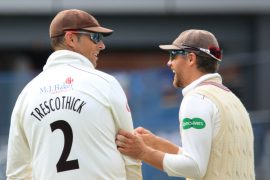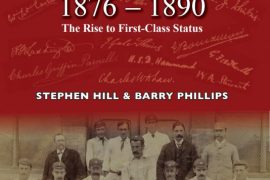
by Steve Tancock with thanks to Stephen Hill and Barry Phillips, authors of “Somerset Cricketers ….“

The mid to late 1970s were the most wonderful time to be growing up as a cricket-mad lad in Taunton. Fair play to my Mum and Dad – they couldn’t have timed my arrival into the world better than they did. I was able to feel the pain of being a Somerset supporter first-hand in the early ‘70s before the glory years arrived. An experience that made the latter all the more enjoyable especially as it was in the company of my Dad, who had suffered far longer than I had which made me appreciate the success even more.
My cricket obsession extended into my education. When you convince your form teacher that the best way to develop mathematical skills was to spend most of the last summer of junior school listening to the England v New Zealand Test Series in school time, scoring ball by ball, and then to through the scorebook with him “marking” it, you knew even at such a young age, that life doesn’t get much better.
I suspect some of this leniency was due to the fact that I had somehow managed to get into Huish’s in 1973 but my first year there didn’t go as planned. A serious illness that resulted in me being hospitalised in the early part of 1974 combined with being taught Maths in the dustiest way possible by a retired Lieutenant-Colonel eroded the love of that subject I’d left Trinity Juniors with and left me near the bottom of the class academically.
And then at the start of my second year, Roy Smith walked into the classroom and into my life. Looking back almost 50 years it is clear that that was one of those moments that changed my life. The man who was to inspired me in Maths, in cricket and in life was a maths teacher called Roy Smith. His infectious enthusiasm for the subject, his students and life, combined with his easy-going nature (which brought out the best in the 12 year old me) made an immediate impression. Roy Smith rekindled my love of the maths, learning was easy, fun and never a chore. I was embarked on a life and career which was founded on a love of numbers and statistics.

To give an example of what it was like being taught by Roy I am going to explain the title of this piece. I vividly recall that lesson and even the classroom it was taught in. We were being introduced to trigonometry and were, collectively, struggling to come to terms with the formulas for calculating, sines, cosines and tangents. Roy told us time and again “soh, cah, toa” i.e. sine = opposite/hypotenuse but we could never remember. And then he commented something along the lines of, “Come on how difficult can it be? Soh, cah, toa, its Maori for, “Hey up, there’s an emu coming”. And that was it, it stuck, never forgotten. That was the man’s genius, he was a natural teacher and knew how to engage with you and help you learn. The fact that I remember that moment so clearly so many years later says it all.
I am not sure how long after he started teaching me it was that I found out that Mr Smith and my Dad were contemporaries at Huish’s, something that for some reason really impressed me. Dad told me that Roy had played for Somerset and shared his memories of his former school contemporary. For a twelve-year-old cricket-mad Tauntonian that elevated the man at the front of my maths class to almost God-like status.
So imagine how I felt when the summer term came round in my second year and I was lucky enough to be getting regular coaching from Mr Smith. Nets were, like his maths lessons, fun but he made you work hard and really really wanted to help you improve. As I progressed through Huish’s and got progressively physically bigger and stronger it was Roy who suggested to me that I try bowling seam rather than spin and then spent countless hours with me in the nets helping smooth the transition. He never was though, for all his abilities as a coach and teacher able to do much about my batting!
My favourite recollection of those coaching sessions was that he would bat last at each net session (telling us that he wanted to tire us out before he faced us). He would put a price on off, middle and leg stumps, usually a pastie, a cream doughnut or a bag of crisps and then challenge us to hit the relevant piece of wood. It didn’t happen very often but when it did he would meet you in the tuck shop queue and happily pay for the reward we had earned.
You were aware from seeing him bat and bowl that Roy was an exceptional sportsman but that was not because of anything he said. It was quite the opposite. You had to drag out of him any stories about his cricketing career. You see the thing about Roy Smith was that, in the words of his daughter Jill “he was always so shy about his cricketing days.” And as she understandably adds, “I was always so proud.”

One final story about how he supported me during my time at Huish’s. To my lasting shame I scored a spectacular own goal playing for the school team. A deliciously chipped back pass which sailed over our keeper and was the deciding§§ goal in a 2-1 defeat in a semi-final. To say I was not popular in school or with the sports teachers in the succeeding days was an understatement. Roy took me aside after a Maths lesson one morning and told me that he knew how I felt, mentioned something similar had happened to him once in “quite an important game” and told me I was good enough to come through this and it would make me better. He was right of course. It wasn’t until I read Steve and Barry’s biography that I found out how important a game it was for Roy! Indeed he never once mentioned in all that time how close he came to signing for one of the country’s top teams.
The other abiding memory of Roy, which is in my mind’s eye as I right this, is of him walking his dog, every day, rain or shine for miles and miles around the town. Even long after I’d left Huish’s he would always stop and chat, genuinely interested in how my academic / working and sporting lives were progressing.
Roy sadly passed away last year but his memory, and my affection and thanks for him will be with me for ever. The kindest man, a natural sportsman and teacher. And for me someone who shaped my life in so many ways. I could never express how much I owe him.
Here, in the words of Stephen Hill and Barry Phillips and with my grateful thanks, is the unabridged official biography published in “Somerset Cricketers, 1946-1970”
373 Roy Smith
22 June 1949 v. Cambridge University, Bath
A diminutive character with a big heart, we are given an insight into Roy Smith’s approach to the game of cricket by H. J. Channon, writing in the Somerset County Herald. Channon observes that ‘Roy is in the nets at every possible moment and no day is long enough for practice’ and that he ‘pesters bowlers as to faults in his batting and gets them to bowl ball after ball until he has mastered it’. We are also informed that ‘Roy’s cup of enthusiasm brims over. He is a sparkling fieldsman.’
Roy also showed great promise as a footballer. At sixteen, he had been turning out for Ilfracombe as a centre-half, attracting the attention of Liverpool FC. Roy would happily inform people that he had the distinction of scoring a goal for the club in a friendly fixture, although sadly it was an own goal, which, he noted, rather scuppered his chances of a regular place. The following year, he had joined the ground staff at Tottenham Hotspur after three trials as a right-half. He was remoulded into a left back but a career in the upper echelons never materialised and he later plied his trade for a variety of local clubs in Devon and Somerset.
He was born in Taunton on 14 February 1930 (and not 14 April as listed in some sources). His parents, Edith May Quick and Albert Le Breton Smith, met while Albert was stationed in Taunton with the Somerset Light Infantry. Albert lived a chaotic life, regularly moving from one job to the next and adopting a casual attitude towards authority which proved disruptive during Roy’s childhood years. Despite this, Roy retained happy memories of his upbringing until his mother died in 1943 of cerebral thrombosis. The thirteen-year-old boy was devastated by the loss. Albert’s hastily arranged and short-lived marriage to Rose May Webber, recently widowed, proved one of his more hare-brained attempts to do the right thing for his son and soon descended into acrimony. Albert eventually settled down with a good friend, whom Roy’s daughter remembers as ‘Grandma Elsie, a very kindly lady who adored dad [Roy]’ and brought stability to Albert and Roy’s lives.
Roy was a pupil at Huish’s Grammar School at the time of his mother’s death but his father sold the family home in April 1944 and shortly thereafter decamped with Roy to Woolacombe, in Devon. Here, Roy completed his education at the grammar school in Ilfracombe while Albert, determined to start afresh, applied successfully for a licence to offer donkey rides on Mortenhoe Beach. There was a comical twist to events when Albert was issued with an ultimatum by the local authority that his licence would be revoked unless he replaced one of the more feral among the donkeys that was causing mayhem. Indeed Roy harboured vivid memories of being dragged along by more than one of the donkeys as he tried to bring them under control. Albert had been a man prepared to try anything but he clearly lacked an eye for a tame donkey. When not struggling to control the recalcitrant beasts, Roy would play football and cricket and was soon making waves with North Devon CC. Seen as an all-rounder, his main skills were as a slow left-arm bowler with news of his ability spreading beyond the bounds of Devon. In his first full season in club cricket, the seventeen-year-old had taken 119 wickets at 7.80 apiece. Over the next two summers he enhanced his reputation with some fine performances for Somerset Colts with bat and ball. He was drawn into the Somerset fold and offered a job in the office at the County Ground, working for Assistant Secretary, Nigel Daniell. Such was his burgeoning reputation that Somerset’s captain, George Woodhouse – speaking in an interview with John Arlott – referred to Roy as ‘the new Jack White’. Alas, Somerset’s hopes would in time be deflated, though not through any lack of application on Roy’s part.
After the club’s Honorary Secretary, Brigadier Lancaster, had had a word in the right places, Roy undertook his National Service at Norton Fitzwarren, near Taunton, in 1949 and while based there he took 8 wickets for 56 in a trial match for The Army. He was selected to play against Oxford University although, on a wicket more suited to the seam bowlers, he was not asked to bowl. Meanwhile, the promising youngster was coached by Jack White on the basis that although the best deliveries were deadly, his line and length were erratic. Sadly, although he learned to replicate the great master’s action and metronomic efficiency, his ability to take wickets was diminished. Somerset offered him a professional contract from the start of the 1950 season and persisted with him for 96 matches until 1955, but he never managed to live up to his early promise. He only ever took 19 wickets at 57.00 apiece. He also averaged 17.10 as a batsman and completed one century and nine half-centuries. A highlight was his 77 not out against the touring Australians in 1953 although he enjoyed a fortunate escape when one delivery hit the stumps but failed to remove the bails.
He had been a popular member of the side, a happy and smiling presence. He had also proved a man of principal, a committed teetotaller unprepared to countenance the gambling that was part of the culture in the dressing room. Perhaps their shared outlook was the reason for a close bond that existed between Johnny Lawrence and Roy. When not employed as a professional footballer in local circles, Roy was invited on occasions to take part in coaching sessions at Johnny’s cricket school in Rothwell and stayed with the Lawrence family. His relationship with Maurice Tremlett was less cordial and Roy would later cite the moment their relationship took a turn for the worse. He had refused as a young rookie (appearing as twelfth man) to make a trip to the bookmaker’s to place bets on Maurice’s behalf.
Roy was married in 1954 to Mary Rutt, a dental nurse in Taunton and the daughter of Cyril and Hilda Rutt, who both taught at Huish’s Grammar School. Mary would later quip that her father’s response on hearing the news was to remark: ‘Of all the boys who went through Huish’s, you had to choose Smith.’ Roy in fact got on well with Cyril and just as his childhood, for all the occasional setbacks, had been filled with fun and laughter, so it was with Roy and Mary and their two daughters.
Roy had previously found work where he could during the winter months above and beyond his time as a football pro and part-time cricket coach. Despite his being a teetotaller, he had been an employee at the Taunton Cider Company and he had enjoyed a period working for Stansells the Builders. He had even completed a stint as a conjurer’s assistant working alongside his father. Albert had decided to become an illusionist after parting with his donkeys, but he had fallen ill and died shortly after his final appearance at Ilminster in 1952. Having realised that his time as a professional cricketer was drawing to a close and encouraged, perhaps, by his in-laws, Roy trained at St Luke’s College, Exeter, to become a teacher and joined the staff at Huish’s. His father-in-law, known to his pupils as ‘Ginger’ Rutt, was a strict disciplinarian and an object of terror for many a schoolboy. His firm methods were a counterpoint to the caring, cheerful and self-deprecating manner of his son-in-law. As well as teaching Maths, Roy took on responsibility for coaching the school cricket and football teams.
He left Huish’s in July 1978 (when the comprehensive system was introduced to Taunton and the school became a sixth form college) and he began teaching in September 1978 at Monkton Heathfield on the outskirts of Taunton. He was not happy there, opting to take early retirement. He and his wife enjoyed a contented spell thereafter in Taunton but when Mary died in 1993, Roy could not face the prospect of remaining in the family home. He moved to Teignmouth and later Dawlish, living for many years with a companion who had long been a family friend. Following her death in 2013, he moved to Weston-super-Mare, close to his daughter, Jill, a caring man now – at the time of writing – in the care of his loved ones as the problems of old age begin to beset him.
His sunny disposition with laughter and a smile never far away, his infectious enthusiasm and his quiet diligence all made him a much-loved teammate, teacher and family man.”

















